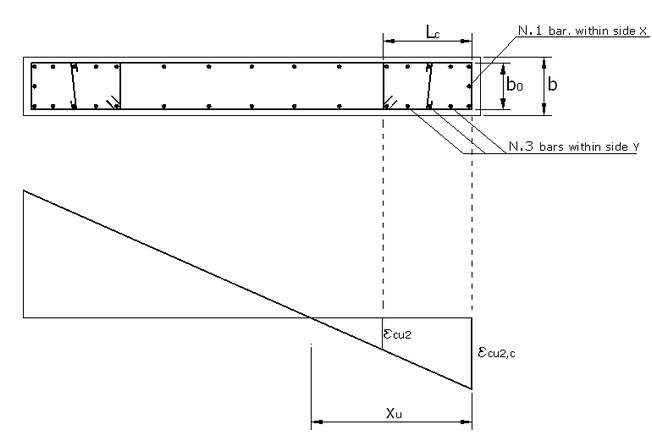The rectangular sections of the walls must have an aspect ratio greater than 4 and for seismic design (cantilever behavior with plastic hinge at base and bending moments without sign reversal at least the first two floors) shall have a minimum cross-dimension 1.5 meters in the case of low-rise buildings and at least 2.0 meters tall buildings. The seismic wall sections are characterized by confinement, with special hoops at the end zones in order to confine the vertical reinforcement that resists to flexural strength. The central area of the section (web) is reinforced with horizontal and vertical bars mainly intended to absorb the shear stresses. There are two main types for the seismic walls (see EC8 in /2/):
• Ductile walls: with a strong degree of interlocking the base and sufficiently slender to be able to develop a plastic hinge at the base (the remaining part of the wall must instead remain in the elastic range). The design can be done either in DCM or in DCH.
• Lightly reinforced walls: whose considerable transverse dimension (> 4 m or > 2/3 height of the wall) makes impossible the formation of a plastic hinge and can not prevent the rotation at the base. The design is expected only in DCM.
•Wall outside the critical area: the sections located above the critical zone not strictly require the confinement with special stirrups of the end zones, however it is recommended in any case its prediction even if they do not follow the rules of transverse reinforcement detail of EC8 code in the critical zone. Even in the absence of stirrups of confinement (or for non seismic wall) we recommend to define the length of the critical area for the sole purpose of the positioning of vertical reinforcement of the extremities.
Section Data dialog window is the following:

Principal data to enter in the above dialog window:
Type of wall
•Ductile wall: in the General Data window you must preliminary enter the position of the current section into the wall: within or out the height of the critical region [see §5.4.3.4.2(1)]. In General Data should also entered the ductility class (DCM or DCH). In CDH the conformity check is much more difficult then in CDM. In DCH if the ratio between the height to length is not greater then 2.0 the wall is "squat": this fact is to be entered in the pertinent check-box.
•Large lightly reinforced wall: boundary region must be always confined also out of the critical region. Ductility class can be only CDM.
Concrete section data
For this type of section is expected only checks (no design of reinforcement).
Are to be entered the concrete class, the sizes of the rectangular section and the length Lc of the confined boundary elements measured by the distance between the axes of the confining hoops (as you see in below figure). Main vertical bars for bending will be placed within the width Lc. In the case in which the amount of vertical bars to be placed in the boundary elements is insufficient, the measure Lc previously assigned will be increased. The same in the case when the compressed area (due to bending deformation) with strain exceeding 0.0035 should fall outside of Lc (that is if the strain εcu2 in the figure below exceeds 0.0035). As clarification of the adopted symbols, see the graph below:

Reinforcement of each confined boundary region
Must be assigned the steel grade, the number, diameter and cover of intermediate bars (over the fixed 4 corner bars) placed along sides parallel to X axis and along sides parallel to Y axis. The four corner bars are not to be entered as they are considered always present in the boundary elements. Diameter and pitch of confining hoops complete the input data of this reinforcement.
Reinforcement of not confined region (web)
In the web region must be entered the diameter and the number of vertical and horizontal bars assegnati placed along each two side of the web.
Calculation data
In the case of large lightly reinforced wall must be entered only the behaviour factor q. For ductile wall in CDM must be entered the basic behaviour factor q0 , T1 (fundamental period of vibration of the building) and Tc (upper limit period of the constant spectral acceleration region of the spectrum). For ductile wall in CDH are also necessary the spectral values Se(T1) and Se(Tc).